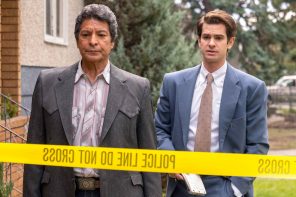Spoiler: this recap covers some of the crucial investigative developments featured in the second episode of Murder Among the Mormons, a new documentary released this week by Netflix. A recap of the first episode can be read here, while a recap of the final episode can be read here. An overview essay appeared here.
“I learned my Mormon [from the investigation].” -Detective Gerry D’Elia
The most haunting video footage from the second episode is that of Mark Hofmann with his family, particularly his children.
By the end of the episode, viewers are well aware that he was responsible for killing two innocent people, and likely intended at least a third victim. Seeing him bouncing a child on his knee and hearing the calming voice of a loving wife, then, offers a seemingly idyllic home life that we don’t like to associate with serial murderers. Americans typically like their villains clear-cut, the black hats of a morality play. But what makes Hofmann’s story so haunting is his chameleon persona, a living Rorschach test who can convincingly reflect only what the observer desires.
The indefinable characteristic that allowed Hofmann to pass as different things to different people, all while hiding his “real” motive, also happens to be a common refrain for understanding Hofmann’s religious tradition. For its first century, Mormonism was America’s outcast, the viper at the hearth that threatened the nation’s morals. Yet in the second century, the Church of Jesus Christ of Latter-day Saints had grown ever closer to the mainstream, assimilating into the culture to which it had previously been excluded. But an undercurrent remained: could Mormons ever be fully trusted? Wasn’t there something that would forever cast them as a peculiar people?
The national spotlight invited by Hofmann’s saga reopened old wounds, as many thought the entire story—scandalous documents, hierarchical censorship, even murder—unveiled the faith’s true aura, the hidden underbelly that they’d carefully hidden. Such was the tenor of the bestselling book on the case, anyway.
Attacking this larger legacy was too large a step for Murder Among the Mormons—though the directors do address some broader questions in the third and final episode—as they instead focus on the enigma of Hofmann himself. That they chose not to dig into his personal past until the middle of the three-part series reveals their desire to intertwine his origins with the crimes. How could someone raised in such a clean-cut, traditional, and even loving family grow up to perpetrate such horrible crimes?
Their apparent answer is by casting Hofmann as a nebulous shapeshifter who, through conniving and skill, could fit whatever situation in which he found himself: a determined missionary who lost his faith, a family man with a wild side, a teetotaler who proved he could never get drunk, and a cold killer who could pass a lie detector test. Ironically, Hofmann fulfilled the stereotypes of the cult leaders found in nineteenth-century anti-Mormon literature—someone who appears clean-cut and trustworthy, yet conceals layers of evil and deception.
If the first episode showed the public side of Hofmann’s exciting document “discoveries,” the second installment focuses on the other side of the coin: his unrelenting desire for more wealth, fame, and power. He spent more than he brought in, accumulated an increasing number of toys, and made frequent trips to the East Coast to both initiate more sales as well as party hard while away from his traditional home life.
Some of the documentary’s tricks to capture this escalation and duplicity work well, like the home-footage of a smiling, and obviously proud, Hofmann watching news footage of himself. Others come up short, like the comedic reenactment of Hofmann and his friend, Shannon Flynn, racing cars and shooting guns, which is over-the-top hokey, accompanied by what the closed captions aptly describe as “exciting 80s music.”
But every true-crime drama needs more than the devious villain; they also need the daring good guys. In Murder Among the Mormons, the men who bring Hofmann to justice are a goofy and loveable group of detectives led by Gerry D’Elia, an outsider to both Utah and its dominant faith who admitted he had to learn about both while on the job.
But their task was tough. Even when their suspicions mounted that Hofmann, who was recovering from the serious injuries caused by a bomb in his car, was actually behind the killings, they were left with a gaping hole: what was his motive?
In the end, it was two things that led to Hofmann’s downfall, the unraveling of a meticulous tapestry that he believed would keep him free. First were eyewitnesses at the first bombing who recognized his green letterman’s jacket; second was his sloppy use of his own name to pay off a laughably small debt for one engraving he had used in forgeries.
There’s a passage in the Book of Mormon that declares, “by small and simple things are great things brought to pass.” In Hofmann’s case, it was small and simple mistakes that caused his entire empire to come crashing down.
Armed with a motive—Hofmann killed to cover up America’s most successful string of forgeries—the detectives brought in investigator George Throckmorton, a forensic document examiner who was able to prove what historians and dealers had failed to notice: a degree of ink cracking that proved modern creation.
In the end, Hofmann was not the perfect criminal he had assumed, and his feeling of invincibility was nothing more than a myth he told himself.
But what does Hofmann’s case tell us about the church he tried to dupe, the faith he had forsaken, the humanity he had cast aside? Those are the biggest questions of all, and ones saved for the final episode.





